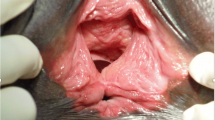Abstract
Purpose
When counseling patients about surgical alternatives for pelvic organ prolapse (POP) repair, numerous things have to be considered. Uterine preservation vs. hysterectomy is one relevant issue. Hysterectomy has been traditionally performed for POP, but its benefit regarding outcome has never been proven. Furthermore, a growing number of women ask for uterine preservation.
Methods
In this retrospective cohort study, 384 patients who had undergone surgery for POP between 2000 and 2012 at Freiburg University Medical Center were included. Using a standardized questionnaire, further surgeries, urinary incontinence, recurrent POP, pessary use, and satisfaction with the surgical outcome were evaluated. The functional results after uterine preservation vs. concomitant hysterectomy were compared using t test.
Results
196 (51.04 %) women were available for follow-up and agreed to participate (n = 122 with hysterectomy, n = 72 with uterine-preserving surgery, respectively). After a mean follow-up time of 67 months, vaginal bulge symptoms and urinary incontinence did not differ between treatment groups. We observed higher success rates and satisfaction scores in the uterine-preserving group. Regarding satisfaction with surgery and whether the patients thought it had been successful, we observed a trend toward better results in the uterine-preserving group (mean satisfaction score: 8.45 ± 2.15 vs. 7.76 ± 2.91, range 0–10, p = 0.061; success: 91.4 vs. 81.7 %, p = 0.087).
Conclusions
There was no difference with regard to functional outcome between patients with or without concomitant hysterectomy. Satisfaction with the operation was slightly higher after uterus preserving surgery. Therefore, uterine-preserving surgery is a valuable option unless there are contraindications.

Similar content being viewed by others
Abbreviations
- Abbreviation :
-
POP Pelvic organ prolapse
References
Smith FJ, Holman CD, Moorin RE, Tsokos N (2010) Lifetime risk of undergoing surgery for pelvic organ prolapse. Obstet Gynecol 116(5):1096–1100
Maher C, Feiner B, Baessler K, Schmid C (2013) Surgical management of pelvic organ prolapse in women. Cochrane Database Syst Rev; 4:CD004014. Review
Cheon C, Maher C (2013) Economics of pelvic organ prolapse surgery. Int Urogynecol J 24(11):1873–1876
Lykke R, Blaakær J, Ottesen B, Gimbel H (2013) Hysterectomy in Denmark 1977–2011: changes in rate, indications, and hospitalization. Eur J Obstet Gynecol Reprod Biol; pii: S0301-2115(13)00461-2
Walters MD, Ridgeway BM (2013) Surgical treatment of vaginal apex prolapse. Obstet Gynecol 121(2 Pt 1):354–374
Rosati M, Bramante S, Bracale U, Pignata G, Azioni G (2013) Efficacy of laparoscopic sacrocervicopexy for apical support of pelvic organ prolapse. JSLS. 17(2):235–244
Lee T, Rosenblum N, Nitti V, Brucker BM (2013) Uterine sparing robotic-assisted laparoscopic sacrohysteropexy for pelvic organ prolapse: safety and feasibility. J Endourol 27(9):1131–1136
Bonney V (1934) The principles that should underline all operations for prolapse. J Obstet Gynaecol Br Empire 41:669–683
Jeppson PC, Sung VW (2013) Hysterectomy for pelvic organ prolapse: indications and techniques. Clin Obstet Gynecol
Gutman R, Maher C (2013) Uterine-preserving POP surgery. Int Urogynecol J 24(11):1803–1813
Persson P, Brynhildsen J, Kjølhede P (2013) Hysterectomy Multicentre Study Group in South-East Sweden. Pelvic organ prolapse after subtotal and total hysterectomy: a long-term follow-up of an open randomised controlled multicentre study. BJOG 120(12):1556–1565
Collinet P, Belot F, Debodinance P, Ha Duc E, Lucot JP, Cosson M (2006) Transvaginal mesh technique for pelvic organ prolapse repair: mesh exposure management and risk factors. Int Urogynecol J Pelvic Floor Dysfunct 17(4):315–320
Caquant F, Collinet P, Debodinance P, Berrocal J, Garbin O, Rosenthal C, Clave H, Villet R, Jacquetin B, Cosson M (2008) Safety of transvaginal mesh procedure: retrospective study of 684 patients. J Obstet Gynaecol Res 34(4):449–456
Farthmann J, Watermann D, Niesel A, Fünfgeld C, Kraus A, Lenz F, Augenstein HJ, Graf E, Gabriel B (2013) Lower exposure rates of partially absorbable mesh compared to nonabsorbable mesh for cystocele treatment: 3-year follow-up of a prospective randomized trial. Int Urogynecol J 24(5):749–758
Costantini E, Porena M, Lazzeri M, Mearini L, Bini V, Zucchi A (2013) Changes in female sexual function after pelvic organ prolapse repair: role of hysterectomy. Int Urogynecol J 24(9):1481–1487
Barber MD, Brubaker L, Nygaard I, Wheeler TL 2nd, Schaffer J, Chen Z, Spino C (2009) Pelvic floor disorders network. defining success after surgery for pelvic organ prolapse. Obstet Gynecol 114(3):600–609
Barber MD, Maher C (2013) Epidemiology and outcome assessment of pelvic organ prolapse. Int Urogynecol J 24(11):1783–1790
Barber MD, Maher C (2013) Apical prolapse. Int Urogynecol J 24(11):1815–1833
Conflict of interest
None.
Author information
Authors and Affiliations
Corresponding author
Rights and permissions
About this article
Cite this article
Farthmann, J., Watermann, D., Erbes, T. et al. Functional outcome after pelvic floor reconstructive surgery with or without concomitant hysterectomy. Arch Gynecol Obstet 291, 573–577 (2015). https://doi.org/10.1007/s00404-014-3435-x
Received:
Accepted:
Published:
Issue Date:
DOI: https://doi.org/10.1007/s00404-014-3435-x




